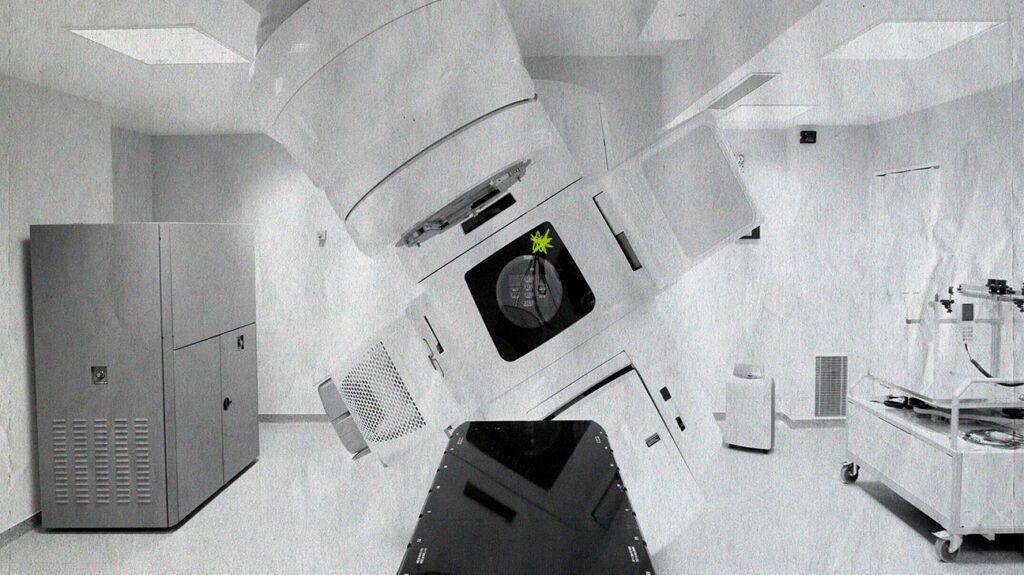Doctors sometimes use radiation therapy to treat early stage non-Hodgkin’s lymphoma (NHL). To treat advanced stages, they may recommend radiation therapy alongside other treatments, such as chemotherapy.
Non-Hodgkin’s lymphoma (NHL) is a cancer that develops in the cells of the immune system. Doctors classify the disease based on the type of lymphocyte it starts in and how the cells look under a microscope. Treatment options might also depend on how far the cancer has spread.
Read on to learn more about radiation therapy as a treatment for NHL. This article looks at when doctors recommend it, what happens during radiation therapy, what the possible side effects are, and more.

Radiation therapy is a cancer treatment that involves using radioactive materials to kill cancer cells. It stops cancer cells from growing by damaging their DNA so that they can no longer divide.
Cancer cells do not die immediately after radiation therapy, and the treatment requires several sessions over
People with NHL
Most people with NHL do not receive radiation. They are
However, doctors
- alongside chemotherapy in more aggressive or advanced cases
- alongside chemotherapy while helping to kill cancer cells throughout the body during stem cell therapy for body-wide lymphoma
- to ease symptoms of advanced lymphoma that has spread to internal organs such as the brain
- to shrink tumors that are pressing on nerves
Learn more about treatments for NHL.
Before radiation treatment for NHL, a person meets with their radiation oncologist. The radiation oncologist will perform scans such as a CT scan or an MRI to determine the external beam radiation treatment area and the angle of the beam.
The radiation oncologist will either draw or tattoo freckle-sized dots to mark the area that needs radiation. These should remain visible for the entire course of radiation therapy. Tattoos will last for life.
Some body areas require a body mold, which the radiation team builds specifically for each person’s body. The mold keeps the person in the exact same position for every session.
During the session, a person will need to change into a hospital robe or gown and enter a low temperature treatment room. Colored lights might be visible near the skin marks to help position the person for treatment, but these lights are harmless.
The radiation oncologist controls the machine from a different room. The beam will usually run for
People receive radiation for NHL
Treatment often lasts for a maximum of 3 weeks. A person’s doctor can provide more accurate information about how long they can expect the treatment to last.
Radiation therapy does not cause pain during the procedure, but it may cause other side effects.
Common radiation therapy side effects
- redness around the site of radiation
- nausea
- diarrhea
- tiredness
Possible serious long-term side effects include:
- breathing problems
- lung damage
- increased risk of heart attack
- memory loss
- personality changes
- trouble concentrating
- increased risk of cancer in the area of radiation therapy
Learn more about the possible side effects of radiation therapy.
The best treatment for NHL is the one that best addresses the type, location, and stage of a person’s specific tumor. This can be different for each person.
However,
Learn about the difference between radiation therapy and chemotherapy.
People with non-Hodgkin’s lymphoma (NHL) may not always receive radiation therapy. However, doctors may recommend it for early stage NHL. Radiation therapy may also ease symptoms for people with advanced lymphoma.
Radiation oncologists most often perform external beam radiation therapy, which usually involves five sessions per week for up to 3 weeks.
Depending on which type of NHL they have, a person might receive radiation therapy on its own or alongside other cancer treatments, such as chemotherapy.
If a person’s doctor recommends radiation therapy, they can provide more information about what the treatment involves, including the benefits and the possible side effects.
